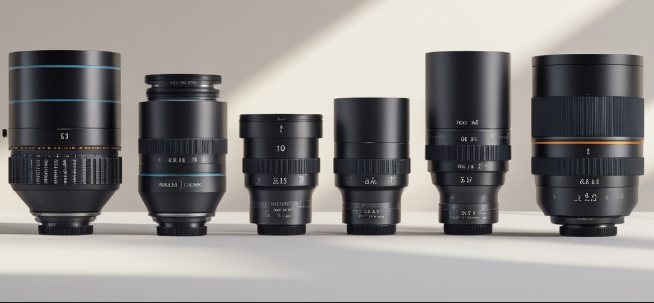Photography is more than just clicking a button; it is a combination of light, optics, creativity, and perspective. One of the most important elements that shapes how a photograph looks is the lens attached to the camera. New photographers often ask why there are so many different types of lenses and whether they all serve a unique purpose. The answer lies in how every scene, subject, and creative style requires a different way of capturing light. Lenses are designed to offer flexibility, control, and variety in visual storytelling, making them essential tools in a photographer’s kit.
Understanding Why Multiple Lenses Exist
Each lens is built to solve different photographic needs, from capturing wide landscapes to zooming in on distant subjects. The variation mainly comes from focal length, aperture range, optical construction, and how each lens handles perspective. These aspects define how wide or close the scene appears, how much of the frame remains in focus, and how the subject is visually separated from the surroundings. Because no single lens can perform every task equally well, photographers choose lenses based on their style, subject matter, and shooting conditions.
Focal Length as the Main Difference
The focal length determines how much of a scene the lens captures. It is measured in millimeters and affects the angle of view. A short focal length shows a wider scene, while a longer focal length zooms in and narrows the frame. This difference influences composition and storytelling. For example, a wide-angle lens can capture a sweeping mountain view and provide a sense of space, while a telephoto lens can isolate a distant bird in great detail. Understanding focal length helps photographers visualize how a subject will appear before taking the shot.
Wide-Angle Lenses
Wide-angle lenses generally range from about 10mm to 35mm. They capture more of the environment and are commonly used for landscapes, architecture, interior photography, and street scenes. These lenses emphasize depth and space, making them suitable when the photographer wants to include more visual information in a single frame.
Standard or Normal Lenses
Standard lenses, usually around 35mm to 50mm, approximate the perspective of the human eye. This makes them ideal for everyday photography, portraits, documentary work, and travel. They create natural-looking images without exaggerating space or compressing distance.
Telephoto Lenses
Telephoto lenses range anywhere from 70mm to 600mm or more. They bring distant subjects closer and reduce the sense of space between objects. They are used for wildlife, sports, events, and sometimes portraits to achieve separation between subject and background. Telephoto lenses help highlight specific subjects in busy environments.
Zoom vs. Prime Lenses
Another reason for the variety is the difference between zoom and prime lenses. Zoom lenses allow the user to change focal lengths without switching lenses. This makes them convenient for situations where adjusting distance is not easy, such as events or travel. Prime lenses, on the other hand, have a fixed focal length but often deliver sharper images, wider apertures, and better low-light performance. This makes primes favored in portrait, filmmaking, and creative work where image quality and aesthetic control matter more than convenience.
How Aperture Influences Lens Use
The aperture controls the amount of light entering the camera and affects depth of field. Lenses with wide apertures (like f/1.8 or f/2.8) allow photographers to shoot in low light and create background blur, known as bokeh. These lenses are popular for portraits and cinema-style visuals. Lenses with narrower apertures allow more of the scene to stay in focus and are useful for landscapes, architecture, and product photography where detail across the frame is essential.
Specialized Lenses and Their Creative Uses
Many lenses are manufactured for specific creative effects. Macro lenses allow close focusing on small subjects such as flowers, jewelry, and insects. They reproduce fine details and are essential for product and scientific photography. Fisheye lenses create extreme wide-angle distortion, often used for artistic or dramatic visual storytelling. Tilt-shift lenses help control perspective in architectural photography by correcting the vertical lines of tall structures. Each of these specialized lenses enhances the photographer’s ability to match the visual output with the purpose.
Choosing the Right Lens Based on Photography Style
The type of photography someone pursues strongly influences which lenses will be most useful. A landscape photographer will likely carry wide-angle lenses to capture expansive vistas, while a wedding photographer may rely on fast prime lenses for portraits and zoom lenses for dynamic coverage of events. Wildlife photographers depend heavily on telephoto lenses, and travel photographers often choose lightweight zooms to stay flexible while moving.
When exploring which lenses suit a photographer’s workflow, it is helpful to compare specifications, reviews, and build quality. Many buyers also consider the current Lenses Price In Pakistan when planning upgrades that fit their creative and budget goals.
Photographers who prefer hands-on testing may visit a trusted camera store in lahore where they can physically inspect lenses, compare handling, and receive professional guidance on equipment choice.
Conclusion
There are many lenses available because photography requires flexibility. Each type of lens provides a unique way to interpret a scene, influence perspective, and shape the final image. From wide-angle storytelling to close-up detail, from natural perspectives to dramatic focus effects, different lenses allow photographers to express creativity with precision. Understanding the role of focal length, aperture, and lens design helps photographers choose the right tools for their artistic or professional needs. Over time, the lens selection a photographer builds becomes a reflection of their personal visual style.


